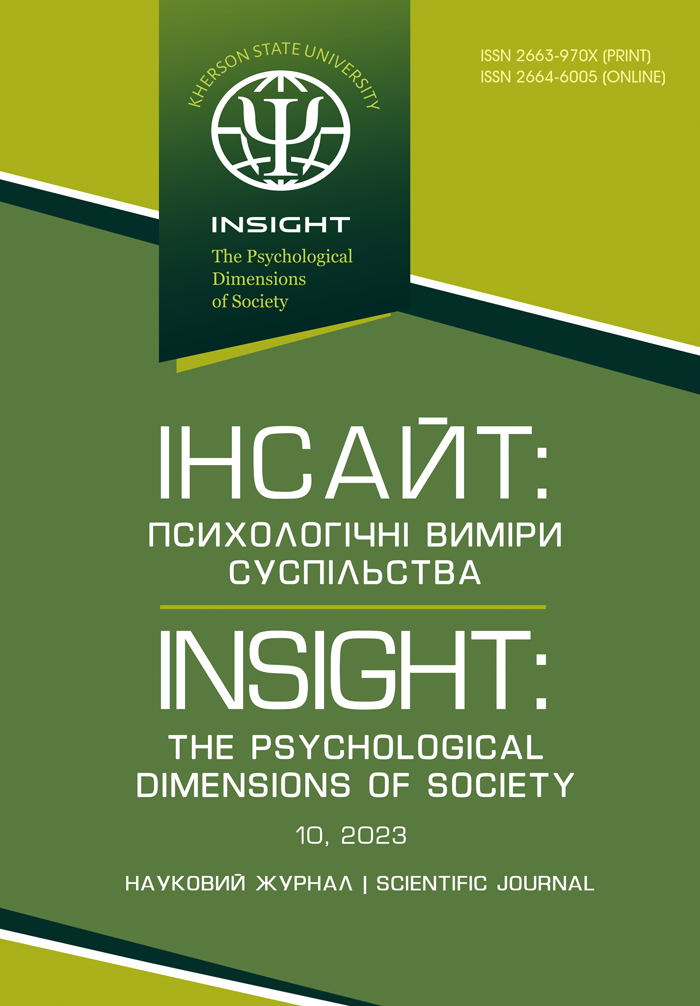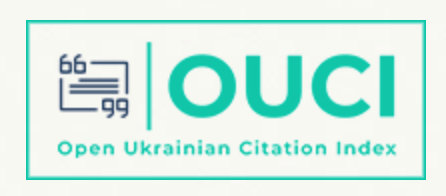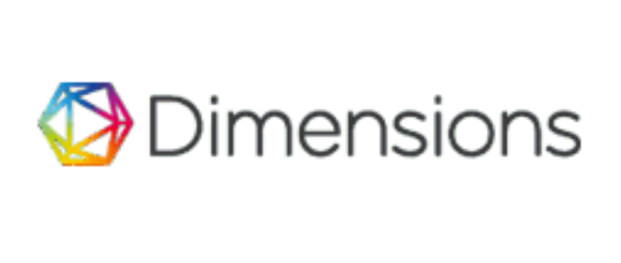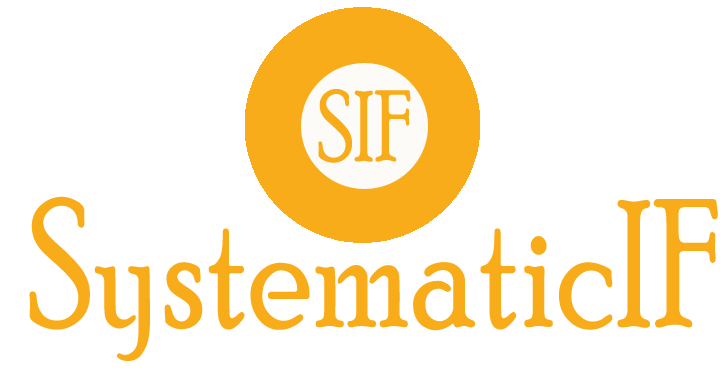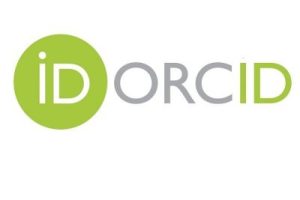Comparison of Life and Meaningful Parameters of Adolescent and Young Adult Drug Addicts
Abstract
The purpose of the article is to empirically investigate and compare the life and meaningful parameters of drug addicts of adolescent and young adult age. An attempt has been made to determine and compare the indicators of subjective control, functional state, and meaningful life orientations of two categories of drug addicts i. e. adolescents and young adults. The empirical basis of the research was made up of two groups of respondents who sought help at the City Addiction Clinical Hospital “Sociotherapy” (Kyiv, Ukraine): adolescent drug addicts aged 18–23 years (n = 52) and young adult patients aged 24–29 years (n = 46). Methods: bibliosemantic, comparative, psychological and diagnostic (valid questionnaires), method of systematic analysis and generalization, mathematical and statistical. Results. It has been found that youth drug addiction is a dynamic phenomenon that reveals concomitant signs of drug addicts’ behavior in different age groups. Adolescents with signs of addiction demonstrate a low level of subjective control, they do not see a connection between their actions and significant events for themselves; they show monotony, which determines the behavior of searching for sources of new sensations. Instead, drug addicts of young adult age are diagnosed with a higher level of subjective control, primarily in interpersonal relationships and in the field of achievement; they have a much higher severity of fatigue. It has been proven that drug addiction makes certain adjustments to the meaningful life orientations of young people. In particular, drug addicts of young adult age (compared to adolescents) have inadequate goals in life; they strive to live for today or even yesterday. Discussion and conclusions. The meaningful parameters of drug addiction among adolescents and young adults have been generalized and substantiated. The differences found in the indicators of respondents’ subjective control over the course and areas of their lives, which is likely to be a temptation to use drugs, have been explained. The peculiarities of the functional state of the respondents’ bodies, as well as the meaningful life orientations of drug-addicted youth have been outlined.
Downloads
References
Aleksandrov, D., Okhrimenko, I., Medvediev, V., Moiseieva, O., & Prontenko, K. (2020). Psychoprophylactic correction of the individual psychological factors of narcotism. BRAIN. Broad Research in Artificial Intelligence and Neuroscience, 11(2), 01–17. https://doi.org/10.18662/brain/11.2/71
Ashar, B. H. (2019). Deviant Behavior. Medical Clinics of North America, 103(5), XV–XVI. https://doi.org/10.1016/j.mcna.2019.05.010
Baklytska, O. P., Baklytsky, I. O., Sirko, R. I., & Slobodianyk, V. I. (2015). Psykhodiahnostyka. Psykholohichnyy praktykum [Psychodiagnosis. Psychological workshop]. Lviv: Spolom. http://repository.ldufk.edu.ua/handle/34606048/17579
Bateson, A., & Dardick, W. R. (2020). A comparison of the two-option versus the four-option multiple-choice item: A case for fewer distractors. Personnel Assessment and Decisions, 6(3), Article 5. https://doi.org/10.25035/pad.2020.03.005
Blum, K., Bowirrat, A., Gomez, L. L., Downs, B. W., Bagchi, D., Barh, D., et al. (2022). Why haven’t we solved the addiction crisis?. Journal of the Neurological Sciences, 442, e120404. https://doi.org/10.1016/j.jns.2022.120404
Bondarenko, V., Okhrimenko, I., Piaskovskyi, V., Antoshchuk, A., & Marchuk, A. (2022). Scientific tools for forming professional competence of patrol police officers. International Journal of Evaluation and Research in Education, 11(2), 687–695. https://doi.org/10.11591/ijere.v11i2.21987
Clerke, J. A., Congiu, M., & Mameli, M. (2021). Neuronal adaptations in the lateral habenula during drug withdrawal: Preclinical evidence for addiction therapy. Neuropharmacology, 192, e108617. https://doi.org/10.1016/j.neuropharm.2021.108617
Costin, A., & Roman, A. F. (2020). Discussing with the parents of high school students: What do they know about drugs?. Postmodern Openings, 11(1), 01–19. https://doi.org/10.18662/po/105
DeYoung, C. G., Beaty, R. E., Genç, E., Latzman, R. D., Passamonti, L., Servaas, M. N., et al. (2022). Personality neuroscience: An emerging field with bright prospects. Personality Science, 3, 1–21. https://doi.org/10.5964/ps.7269
Farisco, M., Evers, K., & Changeux, J. P. (2018). Drug addiction: From neuroscience to ethics. Frontiers in Psychiatry, 9, 595. https://doi.org/10.3389/fpsyt.2018.00595
Garland, E. L. (2021). Mindful positive emotion regulation as a treatment for addiction: from hedonic pleasure to self-transcendent meaning. Current Opinion in Behavioral Sciences, 39, 168–177. https://doi.org/10.1016/j.cobeha.2021.03.019
Graham, D. P., Harding, M. J., & Nielsen, D. A. (2022). Pharmacogenetics of addiction therapy. Methods in Molecular Biology (Clifton, N. J.), 2547, 437–490. https://doi.org/10.1007/978-1-0716-2573-6_16
Griban, G. P., Okhrimenko, I. М., Myroshnychenko, M. S., Tomenko, O. A., Matrosov, S. O., & Rohovenko, M. M. (2022). Ecological education and its relationship with students’ health. Wiadomosci Lekarskie (Warsaw, Poland: 1960), 75(2), 525–532. https://doi.org/10.36740/WLek202202136
Griban, G. P., Yavorska, T. Y., Tkachenko, P. P., Kuvaldina, O. V., Dikhtiarenko, Z. M., Yeromenko, E. A., et al. (2020). Motor activity as the basis of a healthy lifestyle of student youth. Wiadomosci Lekarskie (Warsaw, Poland: 1960), 73(6), 1199–1206. https://doi.org/10.36740/WLek202006123
Hamonniere, T., & Varescon, I. (2018). Metacognitive beliefs in addictive behaviours: A systematic review. Addictive Behaviors, 85, 51–63. https://doi.org/10.1016/j.addbeh.2018.05.018
Iswardani, T., Dewi, Z. L., Mansoer, W. W., & Irwanto, I. (2022). Meaning-making among drug addicts during drug addiction recovery from the perspective of the meaning-making model. Psych, 4(3), 589–604. https://doi.org/10.3390/psych4030045
Morris, N. P., & Bentzley, B. S. (2020). Supporting the use of medications for addiction treatment in US drug courts: Opportunities for health professionals. Journal of Addiction Medicine, 14(4), 277–279. https://doi.org/10.1097/ADM.0000000000000583
Okhrimenko, I. М., Tomenko, O. A., Leonenko, A. V., Cherednichenko, S. V., Krasilov, A. D., Liakhova, N., et al. (2023). Cadets’ motivation for motor activity as an important factor in improving their health. Polski merkuriusz Lekarski : organ Polskiego Towarzystwa Lekarskiego, 51(3), 260–267. https://doi.org/10.36740/Merkur202303113
Olsen, Y. (2022). What is addiction? History, terminology and core concepts. The Medical Clinics of North America, 106(1), 1–12. https://doi.org/10.1016/j.mcna.2021.08.001
Polkhovska, I. K., Sydorenko, A. S., & Melnyk O. D. (2020). The right to medical assistance for drug addicts: Examination of the problem. Wiadomosci Lekarskie (Warsaw, Poland: 1960), 73(12 pt. 2), 2927–2933. https://doi.org/10.36740/WLek202012237
Popovych, I., Blynova, O., Halian, I., & Savchuk, O. (2020). Self-efficacy of future athletes with different levels of psychological safety. Journal of Physical Education and Sport, 20(5), 2718–2724. https://doi.org/10.7752/jpes.2020.05370
Popovych, I., Hoi, N., Koval, I., Vorobel, M., Semenov, O., Semenova, N., et al. (2022). Strengthening of student youth’s mental health using play sports. Journal of Physical Education and Sport, 22(6), 1384–1395. https://doi.org/10.7752/jpes.2022.06174
Razaghi, E., Farhoudian, A. Pilevari, A., Noroozi, A., Hooshyari, Z., Radfar, R., et al. (2023). Identification of the socio-cultural barriers of drug addiction treatment in Iran. Heliyon, 9(5), e15566. https://doi.org/10.1016/j.heliyon.2023.e15566
Rømer Thomsen, K., Callesen, M. B., Hesse, M., Kvamme, T. L., Pedersen, M. M., Pedersen, M. U., et al. (2018). Impulsivity traits and addiction-related behaviors in youth. Journal of Behavioral Addictions, 7(2), 317–330. https://doi.org/10.1556/2006.7.2018.22
Roos, C. R., & Witkiewitz, K. A. (2017). contextual model of self-regulation change mechanisms among individuals with addictive disorders. Clinical Psychology Review, 57, 117–128. https://doi.org/10.1016/j.cpr.2017.08.008
Ruisoto, P., & Contador, I. (2019). The role of stress in drug addiction. An integrative review. Physiology & Behavior, 202, 6 2–68. https://doi.org/10.1016/j.physbeh.2019.01.022
Truong, A., Moukaddam, N., Toledo, A., & Onigu-Otite, E. (2017). Addictive disorders in adolescents. The Psychiatric clinics of North America, 40(3), 475–486. https://doi.org/10.1016/j.psc.2017.05.012
van der Weele, S., Bredewold, F., Leget, C., & Tonkens, E. (2021). What is the problem of dependency? Dependency work reconsidered. Nursing Philosophy: An International Journal for Healthcare Professionals, 22(2), e12327. https://doi.org/10.1111/nup.12327
Verdejo-Garcia, A., Garcia-Fernandez, G., & Dom, G. (2019). Cognition and addiction. Dialogues in ClinicalNeuroscience, 21(3), 281–290. https://doi.org/10.31887/DCNS.2019.21.3/gdom
Volkow, N. D., Jones, E. B., Einstein, E. B., & Wargo, E. M. (2019). Prevention and treatment of opioid misuse and addiction: A review. JAMA Psychiatry, 76(2),
208–216. https://doi.org/10.1001/jamapsychiatry.2018.3126
Wang, S. C., Chen, Y. C., Lee, C. H., & Cheng, C. M. (2019). Opioid addiction, genetic susceptibility, and medical treatments: A review. International Journal of Molecular Sciences, 20(17), 4294. https://doi.org/10.3390/ijms20174294
Authors who publish with scientific journal agree to the following terms:
• All scientific papers may be freely copied and distributed on any medium and in any format, provided that the references to the initial data of the scientific work are indicated.
• Authors retain copyright and grant the journal right of first publication with the work simultaneously licensed Creative Commons Attribution License .
• Authors are able to enter into separate, additional contractual arrangements for the non- exclusive distribution of the journal’s published version of the work (institutional repository, your website, monograph), with an acknowledgement of its initial publication in this journal.


